Subtotal: £120.96
KOI ANGELFISH TROPICAL FISH Pterophyllum, Ideal for Community Tanks – Discover How to Care for These Magnificent Tropical Fish and Ensure Their Wellbeing
£9.49 Original price was: £9.49.£7.74Current price is: £7.74.
Welcome the stunning KOI ANGELFISH TROPICAL FISH (Pterophyllum) into your aquarium for a touch of elegance. These beautiful inhabitants are perfect for beginners and experienced aquarists alike. Enjoy their graceful movements and peaceful nature while providing a thriving home.
1983 in stock
Species Introduction
The Koi Angelfish, scientifically known as Pterophyllum scalare, is a striking member of the Cichlidae family, celebrated for its vibrant colors and graceful fins. Originating from the freshwater rivers and streams of the Amazon Basin, these captivating fish thrive in a variety of aquatic environments. Their natural habitat features slow-moving waters with ample vegetation, providing both shelter and breeding grounds. As a popular choice among aquarists, the Koi Angelfish is not only visually stunning but also offers a fascinating glimpse into the behaviors and interactions of tropical fish. With their unique patterns reminiscent of koi fish, they bring a touch of elegance and serenity to any aquarium setup.
Care Requirements Dashboard
Essential Care Guide for Your Koi Angelfish
| Optimal Living Conditions | |
|---|---|
| Water Temperature | 24-27°C (75-81°F) |
| pH Level | 6.5-7.5 |
| Water Hardness | 4-12 dKH |
| Minimum Tank Size | 80L (20 gal) |
| Salinity | Freshwater |
| Care Level | Beginner Friendly |
✓ Care Level: Moderate
To provide a suitable home for your Koi Angelfish, it is essential to maintain specific care requirements. The ideal tank size for a pair of Koi Angelfish is at least 20 gallons, allowing ample space for swimming and territorial behavior. The water parameters should be closely monitored, with a pH level ranging from 6.5 to 7.5, a temperature between 76°F to 82°F (24°C to 28°C), and a hardness of 3 to 10 dGH. Regular water changes of 25% every two weeks will help maintain optimal water quality, ensuring the health and well-being of these beautiful fish.
Natural Behavior & Temperament
Koi Angelfish exhibit a range of fascinating behaviors that reflect their social nature and adaptability. In their natural habitat, they are often found swimming gracefully among plants and driftwood, showcasing their elegant fins and vibrant colors. These fish are generally peaceful but can display territorial tendencies, especially during breeding periods. It is vital to observe their interactions with tank mates, as they may become aggressive towards smaller or more timid species. Providing plenty of hiding spots and visual barriers within the aquarium can help reduce stress and aggression, allowing your Koi Angelfish to thrive in a community tank setting. Their social nature makes them excellent companions for other peaceful species, making them a great addition to a well-planned tropical aquarium.
Tank Setup Guide
Creating an ideal environment for your Koi Angelfish involves careful consideration of tank setup and decoration. Begin with a spacious aquarium of at least 20 gallons, ensuring that it is equipped with a reliable filtration system to maintain water quality. The substrate should be soft and sandy, allowing for comfortable movement and foraging. Incorporate live plants such as Java fern, Anubias, and Amazon swords, which not only enhance the aesthetic appeal but also provide hiding spots and breeding areas. Additionally, include driftwood and rocks to create a naturalistic environment that mimics their native habitat. Ensure that the lighting is moderate, as excessive brightness can stress these fish. A well-planned tank setup will promote healthy behaviors and reduce aggression, allowing your Koi Angelfish to flourish.
Water Quality Management
Maintaining optimal water quality is crucial for the health and longevity of your Koi Angelfish. Regular testing of water parameters is essential to ensure a stable environment. The pH level should be kept between 6.5 and 7.5, as fluctuations can lead to stress and health issues. The ideal temperature range is between 76°F to 82°F (24°C to 28°C), which mimics their natural habitat. Additionally, the hardness should be maintained between 3 to 10 dGH. It is important to perform regular water changes of 25% every two weeks to remove toxins and replenish essential minerals. Utilizing a high-quality water conditioner will help eliminate harmful chemicals and chlorine from tap water. Monitoring these parameters will not only promote the well-being of your Koi Angelfish but also enhance their vibrant colors and overall vitality.
Feeding & Nutrition
✓ Diet Type: Omnivorous
Koi Angelfish are omnivorous, requiring a balanced diet to thrive. A varied diet should include high-quality flake food, pellets, and occasional live or frozen foods such as brine shrimp, bloodworms, and daphnia. It is recommended to feed your Koi Angelfish 2-3 times a day, providing only what they can consume within a few minutes to prevent overfeeding and water quality issues. Additionally, incorporating vegetable matter such as blanched spinach or spirulina can enhance their diet and promote healthy growth. Observing their feeding habits and adjusting portion sizes accordingly will ensure that your Koi Angelfish remain healthy and vibrant.
Compatibility Guide
When selecting tank mates for your Koi Angelfish, it is crucial to consider their temperament and social behavior. Koi Angelfish are generally peaceful but can become territorial, especially during breeding. Ideal tank mates include other peaceful species such as tetras, rasboras, and larger guppies. Avoid housing them with small or overly aggressive fish, as this can lead to stress and potential harm. A community tank with a variety of species can create a dynamic and engaging environment, but it is essential to monitor interactions closely. Providing ample hiding spots and open swimming areas will help reduce territorial disputes and promote harmony within the tank.
Health & Wellness
Ensuring the health and wellness of your Koi Angelfish requires vigilance and proactive care. Common health issues include ich, fin rot, and swim bladder disease. Regular water quality testing, along with prompt treatment of any abnormalities, is essential for preventing these issues. Signs of illness may include lethargy, loss of appetite, or unusual swimming patterns. If you notice any of these symptoms, it is vital to isolate the affected fish and consult with an aquatic veterinarian for appropriate treatment. Preventative measures such as maintaining stable water parameters, providing a balanced diet, and ensuring a stress-free environment will significantly contribute to the overall health of your Koi Angelfish.
Breeding Information
✓ Breeding Difficulty: Moderate
Breeding Koi Angelfish can be a rewarding experience for aquarists. To encourage breeding, provide a separate breeding tank with a flat surface for the female to lay her eggs. The ideal conditions include slightly warmer water temperatures around 82°F (28°C) and a pH level of 6.5 to 7.0. Once the eggs are laid, the parents will typically guard them diligently. After about 48 hours, the eggs will hatch into fry, which will require infusoria or finely crushed flake food for initial feeding. It is essential to maintain excellent water quality during this period to ensure the survival and growth of the fry. Observing the breeding behaviors and caring for the fry can be an enriching experience, deepening your connection with these beautiful fish.
Acclimation Process
Acclimating your Koi Angelfish to a new aquarium is a critical step in ensuring their health and comfort. Begin by floating the sealed bag containing the fish in the aquarium for about 15 minutes to equalize the temperature. After this, gradually introduce small amounts of tank water into the bag over the course of an hour. This slow acclimation process helps the fish adjust to the new water parameters, reducing the risk of shock. Once acclimated, gently release the fish into the tank using a net to avoid introducing excess bag water. Monitoring their behavior closely during the first few days will help ensure a smooth transition and minimize stress.
Long-term Care
Koi Angelfish can live for over 10 years in a well-maintained aquarium, making long-term care essential for their well-being. Regular monitoring of water parameters, along with consistent feeding and maintenance routines, will contribute to their longevity. As they grow, ensure that the tank size is adequate to accommodate their increasing size and territorial needs. Observing their behavior and interactions with tank mates will help identify any potential issues early on. Additionally, providing a varied diet and maintaining a stress-free environment will promote their health and vitality. By committing to their long-term care, you will foster a thriving community of aquatic companions.
Natural Habitat Recreation
Recreating the natural habitat of Koi Angelfish in your aquarium can enhance their well-being and showcase their beauty. Mimicking the lush, plant-filled environments of the Amazon Basin is key to providing a comfortable home. Incorporate a variety of live plants, such as floating plants, to create shaded areas and reduce stress. Utilizing driftwood and rocks will provide hiding spots and breeding sites, encouraging natural behaviors. Maintaining a gentle water flow and moderate lighting will further replicate their native environment. By creating a biotope that reflects their natural habitat, you will not only enhance the aesthetic appeal of your aquarium but also promote the health and happiness of your Koi Angelfish.
Seasonal Care Adjustments
Seasonal changes can impact the care requirements of your Koi Angelfish. During warmer months, it is crucial to monitor water temperatures closely, as they can rise quickly in heated environments. Ensure that the water temperature remains within the ideal range of 76°F to 82°F (24°C to 28°C) to prevent stress or health issues. In colder months, consider using a heater to maintain stable temperatures. Additionally, adjusting the lighting duration to mimic natural day/night cycles will help regulate their behaviors. Regularly checking water parameters and making necessary adjustments will ensure that your Koi Angelfish remain healthy and vibrant throughout the year.
Expert Tips
✓ Professional Advice: Keep it simple!
When caring for Koi Angelfish, simplicity is key. Avoid overcrowding the tank, as this can lead to stress and health issues. Instead, focus on a few compatible species that enhance the community dynamic. Regularly observe your fish for any signs of stress or illness, and address any issues promptly. Additionally, consider implementing a routine for water changes and tank maintenance to ensure a clean and healthy environment. By following these expert tips, you will create a thriving habitat for your Koi Angelfish, allowing them to flourish and showcase their natural beauty.
Troubleshooting
As with any aquatic companions, challenges may arise while caring for Koi Angelfish. Common issues include aggression, poor water quality, and health problems. If you notice signs of aggression, such as fin nipping or territorial disputes, consider rearranging the tank layout to disrupt established territories. For water quality concerns, regularly test parameters and perform water changes as needed. If health issues arise, isolate affected fish and consult with an aquatic veterinarian for guidance. By being proactive and addressing issues promptly, you can ensure a harmonious and healthy environment for your Koi Angelfish.
Scientific Background
The Koi Angelfish belongs to the family Cichlidae, which encompasses a diverse range of freshwater fish species. Their scientific classification places them within the genus Pterophyllum, which is known for its unique body shape and fin structure. The Koi Angelfish is a selectively bred variant of the standard angelfish, showcasing a distinct coloration pattern that resembles koi fish. This selective breeding has resulted in a variety of color morphs, each with its unique beauty. Understanding the scientific background of Koi Angelfish can enhance your appreciation for these magnificent creatures and inform your care practices.
Advanced Care Techniques
For experienced aquarists looking to elevate their care for Koi Angelfish, advanced techniques can enhance their health and well-being. Implementing a breeding program can be rewarding, allowing for the propagation of these beautiful fish. Additionally, exploring aquascaping techniques can create a visually stunning environment that mimics their natural habitat. Utilizing advanced filtration systems and monitoring technologies can also improve water quality and stability. By continuously learning and adapting your care practices, you can provide the best possible environment for your Koi Angelfish, fostering a thriving community of aquatic companions.
Water Quality Parameters
Optimal Range
24-27°C
6.5-7.5
0 ppm
Caution Zone
22-24°C or 27-29°C
6.0-6.5 or 7.5-8.0
0.25-0.5 ppm
Danger Zone
<22°C or >29°C
<6.0 or >8.0
>0.5 ppm
Monitoring Tip: Test water parameters weekly and perform regular water changes to maintain optimal conditions for your aquatic friends!
Frequently Asked Questions
Q: What tank size is required for Koi Angelfish?
Koi Angelfish require a minimum tank size of 75 litres to thrive. This allows ample swimming space and helps maintain stable water parameters. A larger tank is preferable, particularly if you plan to keep multiple fish, as they can exhibit territorial behaviour. Ensure your aquarium is well-filtered, as Angelfish are sensitive to poor water quality. Additionally, providing vertical space is important, as they enjoy swimming at various levels. A well-planted tank with hiding spots will also help reduce stress and promote natural behaviour.
✓ Expert Tip
Opt for a tank with a height of at least 45 cm, as Koi Angelfish enjoy swimming vertically.
Q: What water parameters do Koi Angelfish require?
Koi Angelfish thrive in water with a temperature between 24-28°C, a pH of 6.5-7.5, and a hardness of 3-10 dH. Regular water testing is essential to ensure these parameters remain stable, as fluctuations can lead to stress and health issues. Use a high-quality water conditioner to remove chlorine and chloramines during water changes. Additionally, maintaining a consistent temperature is crucial, so consider using a reliable heater. Regular partial water changes (about 25% weekly) will help maintain water quality.
✓ Expert Tip
Invest in a good quality test kit to monitor water parameters effectively.
Q: How often should I feed Koi Angelfish?
Koi Angelfish should be fed twice daily, with portions they can consume within 2-3 minutes. A varied diet is essential for their health, so include high-quality flakes, pellets, and occasional treats like frozen or live food such as brine shrimp or bloodworms. This not only enhances their colouration but also mimics their natural feeding behaviour. Overfeeding can lead to water quality issues and obesity, so it is crucial to monitor their intake closely.
✓ Expert Tip
Consider using a feeding ring to help keep food in one area for easy access.
Q: What are the best tank mates for Koi Angelfish?
Koi Angelfish are semi-aggressive and should be housed with compatible species. Ideal tank mates include larger tetras, corydoras, and peaceful gouramis. Avoid small, timid fish, as they may become targets for bullying. It is also wise to steer clear of fin-nippers, such as certain barbs, which can stress your Angelfish. Introducing fish of a similar size and temperament will contribute to a harmonious community tank.
✓ Expert Tip
Always monitor interactions when introducing new tank mates to gauge compatibility.
Q: How do I properly acclimatise Koi Angelfish to my aquarium?
Acclimatising Koi Angelfish is crucial for their health. Begin by floating the sealed bag in your aquarium for about 15-20 minutes to equalise the temperature. After this, gradually introduce small amounts of aquarium water into the bag every 10 minutes for approximately an hour. This process allows the fish to adapt to the water parameters. Finally, gently transfer the fish into the aquarium using a net, discarding the water from the bag to avoid introducing potential contaminants.
✓ Expert Tip
Always acclimatise fish slowly to reduce stress and promote a successful transition.
Q: What are the signs of healthy Koi Angelfish?
Healthy Koi Angelfish exhibit vibrant colours, clear eyes, and active swimming behaviour. They should be responsive to their environment and show no signs of distress, such as clamped fins or unusual swimming patterns. Regular feeding and good appetite are also indicators of health. Additionally, monitor for any visible signs of disease, such as lesions or abnormal growths. Keeping a close eye on their behaviour will help you identify any potential health issues early.
✓ Expert Tip
Regularly observe your fish during feeding times for signs of health and wellbeing.
Q: How do I successfully breed Koi Angelfish?
Breeding Koi Angelfish requires a separate breeding tank of at least 75 litres, with gentle filtration and stable water conditions. Provide flat surfaces, such as slate or broad-leaved plants, for spawning. Ensure the water temperature is slightly elevated (around 28-30°C) to encourage breeding behaviour. Once the eggs are laid, the parents may guard them fiercely. After hatching, remove the parents to prevent them from eating the fry, and feed the fry with infusoria or powdered food until they are large enough for brine shrimp.
✓ Expert Tip
Keep the breeding environment stable and stress-free to increase the chances of successful breeding.
Q: What temperature should I maintain for Koi Angelfish?
The ideal temperature range for Koi Angelfish is between 24-28°C. Maintaining a stable temperature is crucial, as fluctuations can cause stress and predispose them to disease. Use a reliable aquarium heater and thermometer to monitor and adjust the temperature as needed. It is also advisable to avoid placing the tank in direct sunlight or near heating vents, as these can lead to temperature spikes. Regularly check the temperature during water changes to ensure consistency.
✓ Expert Tip
Consider setting up a temperature alarm to alert you to sudden changes.
Q: How long do Koi Angelfish typically live in captivity?
Koi Angelfish can live for 10-15 years in captivity when provided with proper care and optimal living conditions. Factors that contribute to their longevity include stable water parameters, a balanced diet, and a stress-free environment. Regular maintenance, such as water changes and monitoring for diseases, is vital in ensuring their health throughout their lifespan. It is essential to be prepared for their long-term commitment as aquatic companions.
✓ Expert Tip
Keep a detailed log of water parameters and health observations to track their well-being.
Q: What type of substrate is most suitable for Koi Angelfish?
Koi Angelfish prefer a soft substrate that mimics their natural habitat. Fine gravel or sand is ideal, as it allows them to forage naturally and does not cause damage to their delicate fins. A darker substrate can enhance their vibrant colours, making them more visually appealing. Additionally, ensure that the substrate is free from sharp edges and contaminants to prevent injury. Regular cleaning and vacuuming of the substrate will help maintain optimal water quality.
✓ Expert Tip
Consider adding live plants to the substrate for added benefits and aesthetic appeal.
Q: What behavioural patterns should I expect from Koi Angelfish?
Koi Angelfish are known for their graceful swimming and unique personality. They often display territorial behaviour, particularly during breeding periods, and may establish a hierarchy within their environment. They are generally social creatures and enjoy interacting with their surroundings and other fish. Observing their behaviour can provide insights into their health; for instance, hiding or erratic swimming may indicate stress or illness. Providing adequate space and hiding spots can help reduce aggression and promote a peaceful environment.
✓ Expert Tip
Regularly observe your fish to become familiar with their normal behaviour and identify any changes.
Q: How can I prevent common diseases in Koi Angelfish?
Preventing diseases in Koi Angelfish begins with maintaining excellent water quality and stable parameters. Regular water changes and monitoring for ammonia, nitrite, and nitrate levels are crucial. Quarantining new fish before introducing them to the main tank can prevent the spread of diseases. Additionally, providing a varied diet rich in nutrients will strengthen their immune system. Observing your fish for any signs of illness, such as changes in behaviour or appearance, allows for early intervention and treatment.
✓ Expert Tip
Have a basic first aid kit for fish on hand, including medications for common ailments.
Q: What lighting conditions do Koi Angelfish prefer?
Koi Angelfish prefer moderate lighting that mimics their natural habitat. Bright, direct light can cause stress, so using subdued or diffused lighting is beneficial. Ideally, a lighting schedule of 10-12 hours a day is optimal, as it promotes plant growth while allowing the fish to rest. Incorporating floating plants can help create shaded areas in the tank, providing refuge for your Angelfish and enhancing their comfort.
✓ Expert Tip
Consider using a timer for your lighting to maintain consistent day and night cycles.
Q: How do I recognise stress in Koi Angelfish?
Signs of stress in Koi Angelfish include hiding, clamped fins, and erratic swimming patterns. They may also exhibit a lack of appetite or aggression towards tank mates. Changes in colouration, such as dullness or darkening, can indicate stress. It is essential to identify the source of stress, which may include poor water quality, incompatible tank mates, or sudden environmental changes. Regular observation and maintaining stable conditions will help reduce stress and improve your Angelfish’s overall wellbeing.
✓ Expert Tip
Create a calm environment with plenty of hiding spots to help reduce stress levels.
Q: What natural habitat conditions should I replicate for Koi Angelfish?
Koi Angelfish are native to the Amazon Basin, where they inhabit slow-moving waters with plenty of vegetation. To replicate their natural habitat, provide a well-planted aquarium with plenty of hiding spots and open swimming space. Use driftwood and rocks to create structure and mimic their environment. Maintaining slightly acidic to neutral pH levels and stable temperatures will also contribute to their comfort. Regular water changes and proper filtration are essential to keep the habitat clean and healthy.
✓ Expert Tip
Incorporate live plants to enhance the aesthetic and provide natural shelter for your Angelfish.





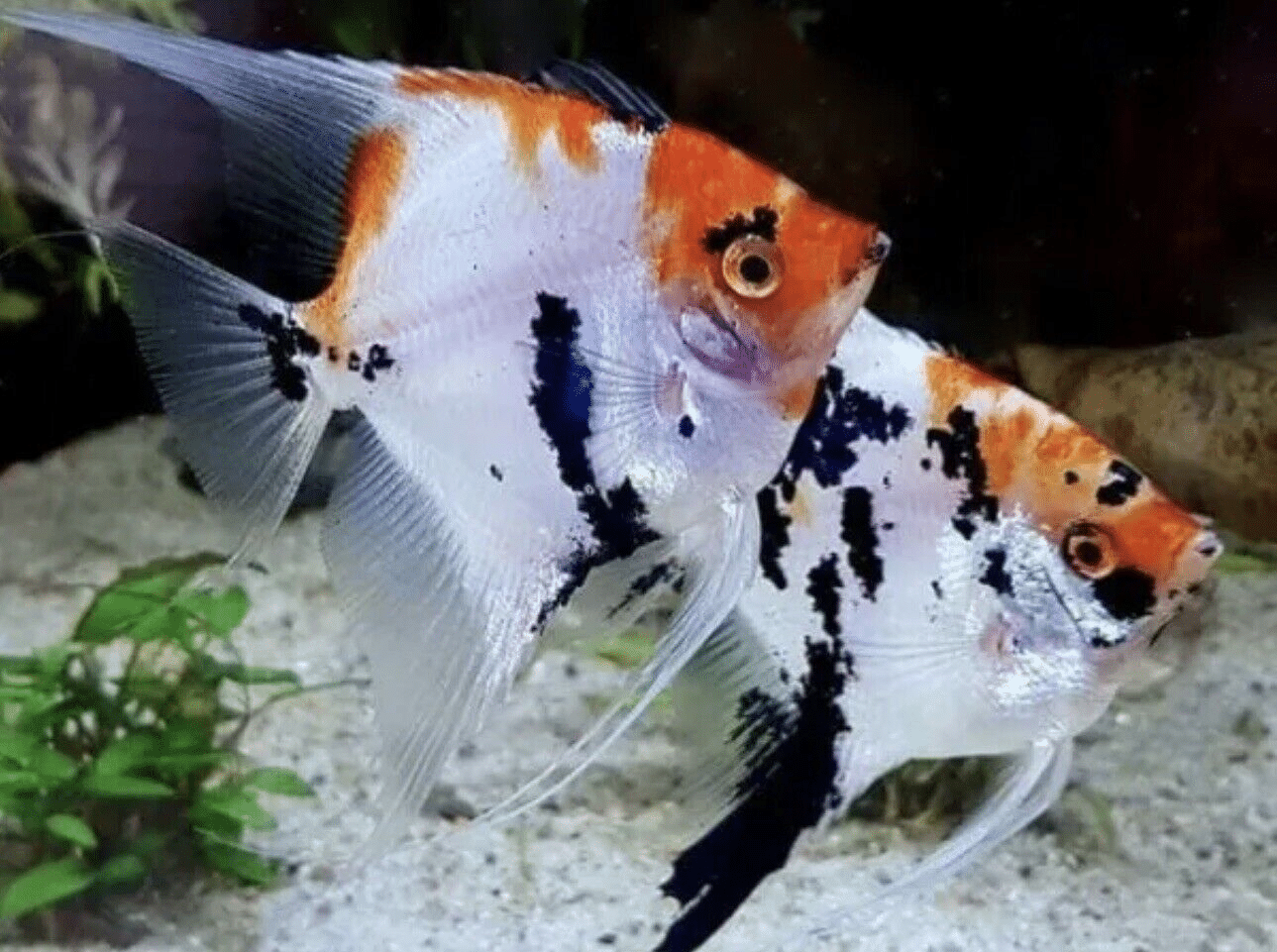
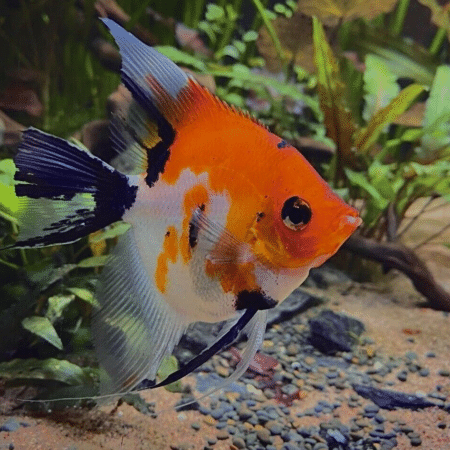

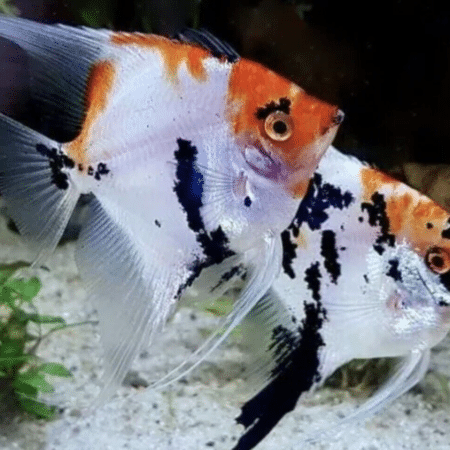
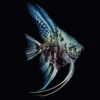
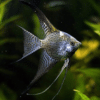









Emily Carter (verified owner) –
I recently added a pair of Koi Angelfish (Pterophyllum) to my aquarium, and I couldn’t be happier! After just two weeks, they have not only adapted beautifully but have also begun to flourish. Their vibrant colors are absolutely mesmerizing, and they swim gracefully, adding life to my tank. I’ve kept various angel fish over the years, but the Koi variety has truly captured my heart due to their unique patterns and personalities.
These fish are peaceful and get along well with my other tank mates, which makes them perfect for a community aquarium. I noticed they enjoy the floating plants I have and often explore their surroundings, which makes me feel like I’m providing a happy home for them.
The only minor concern is that they can be a bit shy at first, but with patience and a calm environment, they really come out of their shells. I highly recommend these Koi Angelfish for anyone from beginner aquarists to seasoned hobbyists. They bring such joy and beauty to any aquarium setup! Overall, I’m thrilled with my purchase and can’t wait to watch them grow.
Do ensure your tank is well-maintained with clean water and plenty of hiding spots for the best health and happiness of your fish.